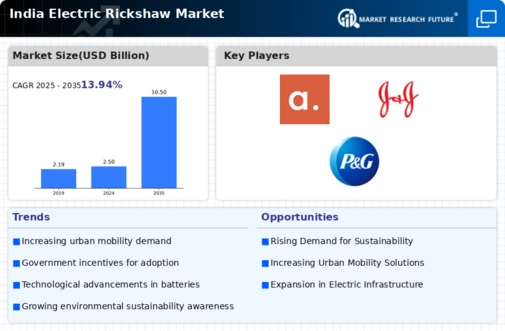Market Growth Projections
The Global India Electric Rickshaw Market Industry is projected to experience substantial growth over the coming years. With a market size expected to reach 2.5 USD Billion by 2024 and 10.5 USD Billion by 2035, the industry is on a robust growth trajectory. The anticipated CAGR of 13.94% from 2025 to 2035 reflects the increasing adoption of electric rickshaws across urban areas. This growth is driven by various factors, including government support, rising environmental awareness, and advancements in technology. As the market evolves, it is likely to attract further investments and innovations, shaping the future of urban mobility.
Government Initiatives and Subsidies
The Global India Electric Rickshaw Market Industry is significantly influenced by government initiatives aimed at promoting electric vehicles. Various state and central government schemes provide financial incentives, subsidies, and tax benefits to manufacturers and consumers. For instance, the Faster Adoption and Manufacturing of Hybrid and Electric Vehicles scheme encourages the adoption of electric rickshaws, making them more affordable for operators. This support is crucial as it not only reduces the initial investment but also fosters a favorable environment for the growth of the electric rickshaw sector. As a result, the market is projected to reach 2.5 USD Billion by 2024.
Environmental Concerns and Sustainability
The Global India Electric Rickshaw Market Industry is increasingly driven by rising environmental concerns and the push for sustainable transportation solutions. Electric rickshaws produce zero tailpipe emissions, which aligns with global efforts to combat air pollution and climate change. As cities grapple with deteriorating air quality, the adoption of electric rickshaws is seen as a viable solution to reduce urban pollution levels. Furthermore, the shift towards sustainable transport is supported by various international agreements and local policies aimed at reducing carbon footprints. This trend is likely to bolster the market's growth as consumers and businesses alike prioritize eco-friendly options.
Technological Advancements in Battery Technology
Technological advancements in battery technology are playing a pivotal role in the Global India Electric Rickshaw Market Industry. Innovations in battery efficiency, charging speed, and lifespan are enhancing the performance of electric rickshaws. Improved lithium-ion batteries, for instance, offer longer ranges and shorter charging times, making electric rickshaws more appealing to operators. These advancements not only increase the operational efficiency of electric rickshaws but also reduce the total cost of ownership. As battery technology continues to evolve, it is expected to drive market growth, with a projected CAGR of 13.94% from 2025 to 2035.
Increasing Investment in Electric Vehicle Infrastructure
The Global India Electric Rickshaw Market Industry is benefitting from increasing investments in electric vehicle infrastructure. Governments and private entities are focusing on developing charging stations and maintenance facilities to support the growing number of electric rickshaws on the roads. This infrastructure development is crucial for alleviating range anxiety among potential users and ensuring the seamless operation of electric rickshaws. As more charging stations become available, the attractiveness of electric rickshaws as a viable transportation option is likely to increase, further propelling market growth.
Rising Urbanization and Demand for Last-Mile Connectivity
Urbanization in India is accelerating, leading to an increased demand for efficient last-mile connectivity solutions. The Global India Electric Rickshaw Market Industry is poised to benefit from this trend, as electric rickshaws offer a cost-effective and environmentally friendly mode of transport. With cities expanding and traffic congestion worsening, electric rickshaws provide a practical alternative to traditional vehicles. They are particularly suitable for short distances, catering to the needs of urban commuters. This growing demand is expected to contribute to the market's expansion, with projections indicating a market size of 10.5 USD Billion by 2035.














Leave a Comment